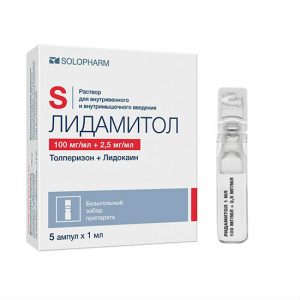Description
release form
sustained-release tablets, almost white in color, oblong, with a risk on both sides, odorless or with a faint odor.
Packing
50 pcs. – polypropylene bottles (2) – packs of cardboard.
Pharmacological action
Anticonvulsant drug, has a central muscle relaxant and sedative effect. It exhibits antiepileptic activity in all types of epilepsy.
The main mechanism of action, apparently, is associated with the effect of valproic acid on the GABA-ergic system: the drug increases the GABA content in the central nervous system and activates the GABA-ergic transmission.
Pharmacokinetics
Absorption
The bioavailability of sodium valproate and valproic acid when administered is close to 100%.
When taking Depakin ® Chrono 500 mg tablets at a dose of 1000 mg / day, Cmin in plasma is 44.7 ± 9.8 μg / ml, and Cmax in plasma is 81.6 ± 15.8 μg / ml. Tmax in plasma is 6.58 ± 2.23 h. Css in plasma is reached within 3-4 days of regular administration of the drug.
The average therapeutic range for serum concentrations of valproic acid is 50-100 mg / L. If it is reasonably necessary to achieve higher concentrations of valproic acid in blood plasma, the ratio of the expected benefit and the risk of side effects, especially dose-dependent, should be carefully weighed, because when the concentration of valproic acid is more than 100 mg / l, an increase in side effects is expected until the development of intoxication. With a plasma concentration of valproic acid of more than 150 mg / l, a dose reduction is required.
Compared to the enteric-coated dosage form, sustained-release tablet formulation in equivalent doses is characterized by the absence of latent absorption time, prolonged absorption, identical bioavailability, lower Cmax (decrease in Cmax by about 25%), but with a more stable plateau phase from 4 to 14 hours after administration, more linear correlation between dose and plasma concentration of the drug.
Distribution of
Binding to plasma proteins (mainly to albumin) is high (90-95%), dose-dependent and saturable.
Vd depends on age and is usually 0.13-0.23 l / kg body weight or in young people 0.13-0.19 l / kg body weight.
Valproic acid penetrates the cerebrospinal fluid and the brain. The concentration of valproic acid in the cerebrospinal fluid is 10% of the corresponding plasma concentration.
Valproic acid passes into breast milk in nursing mothers. In the equilibrium state, the concentration of valproic acid in breast milk is 1-10% of its concentration in plasma.
Metabolism
Metabolized by beta, omega- and omega-1 oxidation and conjugation with glucuronic acid. More than 20 metabolites were isolated, metabolites after omega-oxidation have a hepatotoxic effect.
Valproic acid does not have an inducing effect on isoenzymes of the P450 cytochrome system: unlike most other antiepileptic drugs, valproic acid does not affect the degree of both its own metabolism and the degree of metabolism of other drugs, such as estrogens, progestogens, and indirect anticoagulants.
Excretion
Excreted mainly in urine after beta oxidation and conjugation. T1 / 2 is 15-17 hours. Plasma clearance of valproic acid in patients with epilepsy is 12.7 ml / min.
Pharmacokinetics in special clinical cases
In elderly patients, patients with renal and hepatic insufficiency, binding to plasma proteins is reduced. In severe renal failure, the concentration of the free (therapeutically active) fraction of valproic acid can increase to 8.5-20%.
In case of hypoproteinemia, the total concentration of valproic acid (free + plasma fraction bound to blood proteins) may not change, but it may also decrease due to an increase in the metabolism of the free valproic acid fraction (not bound to blood plasma proteins).
When combined with antiepileptic drugs that induce microsomal liver enzymes, the plasma clearance of valproic acid increases and T1 / 2 decreases, the degree of their change depends on the degree of induction of microsomal liver enzymes by other antiepileptic drugs.
T1 / 2 values in children over 2 months of age are close to those in adults.
In patients with liver disease, valproic acid T1 / 2 increases.
In case of overdose, an increase in T1 / 2 was observed up to 30 h.
Only the free fraction of valproic acid in the blood (10%) undergoes hemodialysis. Moreover, despite taking the drug in a constant dose, a possible decrease in the concentration of valproic acid in plasma. In addition, during pregnancy, a change in the degree of binding of valproic acid to plasma proteins is possible, which can lead to an increase in the serum content of the free (therapeutically active) valproic acid fraction.
Indications
In adults, as monotherapy or in combination with other antiepileptic drugs: treatment of generalized epileptic seizures (clonic, tonic, tonic-clonic, absences, myoclonic, atonic)
paroxysmal paroxysmal seizures secondary generalization or without it)
treatment and prevention of bipolar affective disorders.
In children, as monotherapy or in combination with other antiepileptic drugs: treatment of generalized epileptic seizures (clonic, tonic, tonic-clonic, absences, myoclonic, atonic)
Lennox-Gastaut syndrome
treatment of partial epileptic seizures with secondary or partial without her).
Contraindications
hypersensitivity to sodium valproate, valproic acid, valproate semisodium, valpromid or to any of the auxiliary components of the
preparation acute hepatitis
chronic hepatitis
severe liver diseases (especially drug hepatitis) in the history of the patient and his close blood relatives
severe liver damage with fatal outcome when valproic acid was used in close blood relatives of the patient
severe dysfunction of the liver or pancreas
severe dysfunction of the pancreas
hepatic porphyria
combination with mefloquine
combi tion with drugs St. John’s wort
children under 6 years of age (the risk of getting the tablet into the airway during swallowing).
With caution
liver and pancreas diseases with a history of
pregnancy
congenital fermentopathies
inhibition of bone marrow hematopoiesis (leukopenia, thrombocytopenia, anemia)
renal failure (multiple doses required) )
simultaneous administration of drugs that provoke convulsive seizures or lower the threshold of convulsive readiness, such as tricyclic antidepressants, selective and serotonin reuptake inhibitors phenothiazine derivatives, buterophenone derivatives, chloroquine, bupropion, tramadol (risk of convulsive seizures)
simultaneous administration of antipsychotics, MAO inhibitors, antidepressants, benzodiazepines (the possibility of potentiating their effects)
concomitant use of phenobarbital, primidone, phenytoin, lamotrigine, zidovudine, felbamate, indirect anticoagulants, cimetidine, erythromycin, carbapenems, and rifampicin have a relationship with the pharmacopin blood plasma, a change in plasma concentrations of either these drugs and / or valproic acid is possible)
concomitant use with carbamazepine (risk of potentiation of toxin of the natural effects of carbamazepine and a decrease in the plasma concentration of valproic acid)
concomitant use with topiramate (risk of developing encephalopathy).
Use in cases of impaired liver function
The drug is contraindicated in cases of impaired liver function.
Application for impaired renal function
When using Depakine Chrono in patients with renal failure, it may be necessary to reduce the dose of the drug.
Use in children
For children 6 years of age and older, the average daily dose is 30 mg / kg.
Use in elderly patients
In elderly patients, the dose should be set in accordance with their clinical condition.
Use during pregnancy and lactation
During pregnancy, the development of generalized tonic-clonic epileptic seizures, epileptic status with the development of hypoxia can be a risk factor for death for both the mother and the fetus.
Teratogenic effects of valproic acid have been shown in experimental studies of reproductive toxicity in mice, rats, and rabbits.
Available clinical data confirm that in children born to mothers with epilepsy who received valproic acid, there is an increased frequency of occurrence of intrauterine developmental disorders of varying severity (neural tube malformations craniofacial deformities malformations of the extremities, cardiovascular system as well as multiple intrauterine malformations affecting various organ systems) compared with the frequency of their occurrence when pregnant women take some other antiepileptic drugs.
Based on available data, there is an association between the intrauterine exposure to valproic acid and the risk of developmental delay (especially speech development) in children born to mothers with epilepsy who took valproic acid. Delayed development is often combined with malformations and phenomena of dysmorphism. However, in cases of developmental delay in such children, it is difficult to establish a causal relationship with the use of valproic acid due to the possibility of simultaneous exposure to other factors, such as low intelligence of the mother or both parents, genetic, social factors, environmental factors, insufficient treatment, aimed at preventing epileptic seizures in the mother during pregnancy.
It has also been reported on the development of various autistic disorders in children exposed to intrauterine exposure to valproic acid.
Both valproic acid monotherapy and combination therapy with valproic acid are associated with an unfavorable outcome of pregnancy, but combined antiepileptic therapy including valproic acid has been reported to be associated with a higher risk of an adverse pregnancy outcome compared to valproic acid monotherapy.
In connection with the foregoing, Depakin ® chrono should not be used during pregnancy and in women of childbearing age unless absolutely necessary. Its use is possible, for example, in situations where other antiepileptic drugs are ineffective or the patient does not tolerate them.
The question of whether Depakin ® chrono should be used or whether it should be abandoned should be decided before the use of the drug or reconsidered if a woman receiving Depakin ® chrono is planning a pregnancy.
Women of childbearing age should use effective methods of contraception during treatment with Depakin ® chrono. Women of childbearing age should be informed about the risks and benefits of using valproic acid during pregnancy. When prescribing the drug, pregnancy must be excluded.
If a woman is planning a pregnancy or is diagnosed with pregnancy, then the need for valproic acid treatment should be reassessed depending on the indications: for bipolar disorder, consideration should be given to discontinuing treatment with valproic acid
for epilepsy, the question of continuing treatment with valproic acid or its cancellation is decided after reappraisal the ratio of benefit and risk. If, after reviewing the ratio of benefits and risks, a decision has been made to continue treatment with Depakin ® chrono during pregnancy, it is recommended to use it in the minimum effective daily dose, divided into several doses. It should be noted that during pregnancy, the use of sustained release dosage forms is preferred.
One month before conception and within 2 months after it, folic acid (at a dose of 5 mg / day) should be added to antiepileptic treatment, because this can minimize the risk of neural tube malformations.
Continuous special prenatal monitoring should be performed to identify possible malformations of the neural tube or other fetal malformations.
The development of isolated cases of hemorrhagic syndrome of newborns whose mothers took valproic acid during pregnancy was reported. This hemorrhagic syndrome is associated with hypofibrinogenemia and is possibly due to a decrease in the content of blood coagulation factors. Fatal development of afibrinogenemia has also been reported. This hemorrhagic syndrome should be distinguished from vitamin K deficiency, caused by phenobarbital and other inducers of microsomal liver enzymes.
Therefore, in newborns born to mothers receiving valproic acid, platelet counts, plasma fibrinogen concentrations, blood coagulation factors and coagulograms must be determined.
Cases of hypoglycemia have been reported in newborns whose mothers took valproic acid during the third trimester of pregnancy.
Excretion of valproic acid with breast milk is low, its concentration in breast milk is 1-10% of its plasma concentration. Based on literature data and little clinical experience, with monotherapy with Depakin ® Chrono, mothers can plan breastfeeding, but the profile of side effects of the drug should be taken into account, especially hematological disorders caused by it.
Special instructions
Severe liver damage
Clinical experience has shown that patients at risk are receiving at the same time several antiepileptic drugs, children under 3 years of age with severe convulsive attacks, especially against the background of brain damage, mental retardation and / or congenital metabolic or degenerative diseases.
In children older than 3 years, the risk of liver damage is significantly reduced and progressively decreases with increasing age of the patient. In most cases, liver damage occurs during the first 6 months of treatment.
Clinical monitoring of patients is essential for early diagnosis of liver damage. In particular, attention should be paid to the appearance of the following symptoms that may precede the occurrence of jaundice, especially in patients at risk: nonspecific symptoms, especially those that suddenly began, such as asthenia, anorexia, lethargy, drowsiness, which are sometimes accompanied by recurring vomiting and abdominal pain
resumption of seizures in patients with epilepsy.
Caution patients or their family members (when using the drug in children) that they should immediately report the occurrence of any of these symptoms to their healthcare provider. If these symptoms appear, patients should immediately undergo a clinical examination and a laboratory study of liver function indicators.
Determination of functional liver samples should be performed before treatment and then periodically during the first 6 months of treatment. Among ordinary studies, studies that reflect the state of the protein-synthetic function of the liver, especially the prothrombin index, are the most informative. Confirmation of abnormal prothrombin index, especially in combination with deviations from the norm of other laboratory parameters (a significant decrease in the content of fibrinogen and blood coagulation factors, an increase in the concentration of bilirubin and an increase in the activity of transaminases) requires the cessation of the use of Depakin ® chrono. For the purpose of precaution, if patients received salicylates at the same time, their intake should also be discontinued, as they are metabolized along the same metabolic pathway as valproic acid.
Pancreatitis
Children are at increased risk of developing pancreatitis, with an increase in the child’s age, the risk decreases. Severe convulsions, neurological disorders, or anticonvulsant therapy may be risk factors for pancreatitis. Hepatic failure, combined with pancreatitis, increases the risk of death.
patients, who experience severe abdominal pain, nausea, vomiting and / or anorexia should be examined immediately. If the diagnosis of pancreatitis is confirmed, in particular with increased activity of pancreatic enzymes in the blood, the use of valproic acid should be discontinued and appropriate treatment should be started.
Suicidal thoughts and attempts
Suicidal thoughts or attempts have been reported in patients receiving antiepileptic drugs for some indications. A meta-analysis of randomized, placebo-controlled trials of antiepileptic drugs also showed a slight increase in the risk of suicidal thoughts and attempts. The mechanism of this effect is unknown. Therefore, patients receiving Depakin ® Chrono should be constantly monitored for suicidal thoughts or attempts, and in case of their occurrence, it is necessary to carry out appropriate treatment. Patients and their caregivers are advised if the patient has suicidal thoughts or attempts to immediately consult a doctor.
Renal failure
It may be necessary to reduce the dose of valproic acid due to an increase in the concentration of its free fraction in the blood serum. If it is not possible to monitor plasma concentrations of valproic acid, the dose should be adjusted based on clinical observation of the patient.
Insufficiency of urea cycle enzymes
If you suspect a deficiency of urea cycle enzymes, the use of valproic acid is not recommended. In such patients, several cases of hyperammonemia with a stupor or coma have been described. In these cases, metabolic studies should be performed prior to treatment with valproic acid.
In children with unexplained gastrointestinal symptoms (anorexia, vomiting, cases of cytolysis), a history of lethargy or coma, mental retardation or a family history of death of a newborn or child, metabolic studies should be performed before treatment with valproic acid, in particular determination of ammonia (the presence of ammonia and its compounds in the blood) on an empty stomach and after eating.
Patients with systemic lupus erythematosus
Although it has been shown that during treatment with Depakin ® chrono, immune system dysfunctions are extremely rare, the potential benefits of its use should be compared with the potential risk when prescribing the drug to patients with systemic lupus erythematosus.
Weight gain
Patients should be warned of the risk of weight gain at the beginning of treatment, and measures should be taken, mainly dietary adjustments, to minimize this phenomenon.
Laboratory monitoring
Before starting to use Depakin ® chrono and periodically during the first 6 months of treatment, especially in patients at risk of developing liver damage, a study of liver function should be performed. As with most antiepileptic drugs, a slight increase in the activity of liver enzymes is possible, especially at the beginning of treatment, which proceeds without clinical manifestations and is transient. These patients need a more detailed study of laboratory parameters, including the prothrombin index, and you may need a dose adjustment of the drug, and if necessary, a second clinical and laboratory examination.
Before starting therapy or if surgery is necessary, in case of spontaneous occurrence of subcutaneous hematomas or bleeding, it is recommended to carry out a hematological blood test (to determine the leukocyte blood count, including platelet count, bleeding time and a coagulogram).
Use in pediatrics
In children under 3 years of age, if necessary, the use of valproic acid is recommended to use the drug Depakin ® as monotherapy and in a special dosage form intended for children. In this case, before starting treatment, the ratio of the potential benefits of the use of valproic acid and the risk of liver damage and the development of pancreatitis during its use should be assessed.
In children under 3 years of age, the simultaneous use of salicylates should be avoided due to the risk of hepatotoxicity and bleeding.
Ethanol
Alcohol is not recommended during treatment.
Influence on driving ability and driving mechanisms
Patients should be warned of the risk of drowsiness, especially when combined with anticonvulsant therapy or with valproic acid and benzodiazepines.
During the treatment period, you must be careful and discuss with your doctor the possibility of driving vehicles and engaging in other potentially dangerous activities that require an increased concentration of attention and speed of psychomotor reactions.
Composition
1 tab.
sodium valproate * 199.8 mg
valproic acid * 87 mg
Excipients: methylhydroxypropyl cellulose 4000 mPa.s (hypromellose) – 105.6 mg, ethyl cellulose (20 mPa.s) – 7.2 mg, sodium saccharin – 6 mg, silicon dioxide 32.4 mg methyl hydroxypropyl cellulose 6 MPa.s (hypromellose) – 4.8 mg, 30% polyacrylate dispersion – 16 mg, macrogol 6000 – 4.8 mg, talc – 4.8 mg, titanium dioxide – 0.8 mg.
* corresponds to 300 mg of valproic acid in 1 tab.
Drug interactions
Effect of valproic acid on other
drugs Valproic acid can potentiate the effects of other psychotropic drugs, such as antipsychotics, MAO inhibitors, antidepressants, benzodiazepines (clinical monitoring and, if necessary, dose adjustment of the corresponding drug are recommended).
Valproic acid does not affect serum lithium concentration.
Valproic acid increases the concentration of phenobarbital in plasma (due to a decrease in its hepatic metabolism), and therefore the development of the sedative effect of the latter is possible, especially in children. Therefore, careful medical monitoring of the patient during the first 15 days of combination therapy with an immediate reduction in the dose of phenobarbital in case of sedation and, if necessary, determination of the plasma concentration of phenobarbital is recommended.
Valproic acid increases the concentration of primidone in the plasma, which leads to an increase in its side effects (such as sedation) with prolonged treatment, these symptoms disappear. Careful clinical monitoring of the patient is recommended, especially at the beginning of combination therapy with dose adjustment of primidone, if necessary.
Valproic acid reduces the total concentration of phenytoin in plasma. Moreover, valproic acid increases the concentration of the free fraction of phenytoin with the possibility of developing symptoms of an overdose (valproic acid displaces phenytoin from communication with blood plasma proteins and slows down its hepatic metabolism). Therefore, careful clinical monitoring of the patient and determination of the concentration of phenytoin and its free fraction in the blood are recommended.
With the simultaneous use of valproic acid and carbamazepine, the occurrence of clinical manifestations of toxicity of carbamazepine was reported, because valproic acid may potentiate the toxic effects of carbamazepine. Careful clinical monitoring of such patients is recommended, especially at the beginning of combination therapy with the correction, if necessary, of the dose of carbamazepine.
Valproic acid slows down the metabolism of lamotrigine in the liver and increases T1 / 2 of lamotrigine almost 2 times. This interaction can lead to increased toxicity of lamotrigine, in particular to the development of severe skin reactions, including toxic epidermal necrolysis. Therefore, careful clinical observation and, if necessary, correction (reduction) of the dose of lamotrigine is recommended.
Valproic acid may increase plasma concentrations of zidovudine, leading to increased toxicity of zidovudine.
Valproic acid can lower average felbamate clearance by 16%.
Strengthening the hypotensive effect of nimodipine (for oral administration and, by extrapolation, for parenteral administration) due to an increase in its plasma concentration (inhibition of nimodipine metabolism by valproic acid).
Effect of other drugs on valproic acid
Antiepileptic drugs that can induce microsomal liver enzymes (including phenytoin, phenobarbital, carbamazepine) lower the plasma concentration of valproic acid. In the case of combination therapy, the dose of valproic acid should be adjusted depending on the clinical response and the concentration of valproic acid in the blood.
With the combination of felbamate and valproic acid, the clearance of valproic acid is reduced by 22-50% and the plasma concentration of valproic acid increases accordingly. The plasma concentration of valproic acid should be monitored.
Mefloquine accelerates the metabolism of valproic acid and is capable of causing seizures, therefore, when used simultaneously, an epileptic seizure may develop.
With the simultaneous use of valproic acid and Hypericum perforatum preparations, a decrease in the anticonvulsant effectiveness of valproic acid is possible.
In the case of simultaneous use of valproic acid and drugs that have a high and strong bond with blood plasma proteins (acetylsalicylic acid), an increase in the concentration of the free fraction of valproic acid is possible.
With the simultaneous use of valproic acid and indirect anticoagulants, careful monitoring of the prothrombin index is required.
The concentration of valproic acid in blood plasma may increase with the simultaneous use of cimetidine or erythromycin (as a result of a slowdown in its hepatic metabolism).
Decreased concentrations of valproic acid in the blood when it is used simultaneously with carbapenems (panipenem, meropenem, imipenem), leading to a 60-100% decrease in the concentration of valproic acid in blood plasma in 2 days of joint therapy, which is sometimes combined with the occurrence of seizures. The simultaneous use of carbapenems in patients with a selected dose of valproic acid should be avoided due to their ability to quickly and intensively reduce the concentration of valproic acid in plasma. If treatment with carbapenems cannot be avoided, careful monitoring of valproic acid concentrations in the blood should be carried out.
Rifampicin may lower the concentration of valproic acid in the blood, which leads to the loss of the therapeutic effect of Depakin ® chrono. Therefore, you may need to increase the dose of Depakin ® chrono while using rifampicin.
Another interaction
The simultaneous use of valproic acid and topiramate was accompanied by encephalopathy and / or hyperammonemia. Patients receiving this combination need careful medical supervision for the development of symptoms of hyperammonemic encephalopathy.
Valproic acid does not have the ability to induce liver enzymes and as a result, valproic acid does not reduce the effectiveness of estrogen-progestogen drugs in women using hormonal contraception.
When ethanol and other potentially hepatotoxic drugs are taken concomitantly with valproic acid, the hepatotoxic effect of valproic acid may be enhanced.
The simultaneous use of clonazepam with valproic acid can in rare cases lead to an increase in the severity of the abscess status.
With the simultaneous use of drugs with myelotoxic effect, with valproic acid, the risk of inhibition of bone marrow hematopoiesis is increased.
Overdose
Symptoms: coma with muscle hypotension, hyporeflexia, miosis, respiratory depression, metabolic acidosis cases of intracranial hypertension associated with brain edema have been described. Symptoms may vary, convulsive seizures have been reported at very high plasma concentrations of valproic acid.
Fatal outcome with significant overdose, however, the outlook is usually favorable.
Treatment: in the hospital – gastric lavage, which is effective for 10-12 hours after taking the drug monitoring and correction of the functional state of the cardiovascular and respiratory systems, maintaining effective diuresis. In some cases, naloxone was successfully used. In very severe cases of significant overdose were effective hemodialysis and hemoperfusion.
Storage conditions
The product should be stored out of the reach of children, in a dry place at temperatures below 25 ° C.
Shelf life
3 years.
Deystvuyushtee substance
Valyproevaya Chisloth
Pharmacy terms Pharmacies
prescription
Dosage form prolonged
tablets.
Possible product names
Depakin chrono 300mg No. 100 tab
DEPAKIN CHRONO 300MG. No. 100 TAB.
DEPAKIN CHRONO TAB. PROLONG. ACTION PO / 300MG No. 100
DEPAKIN CHRONO TAB. PROLONG. PO / 300MG No. 100 (01.08)
DEPAKIN CHRONO TAB.PROLONG.P.O. 300MG No. 100
Sanofi-Aventis, France




